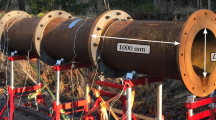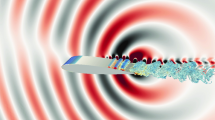Abstract
This paper focuses on numerical simulations of bluff body aerodynamics with three-dimensional CFD (computational fluid dynamics) modeling, where a computational scheme for fluid-structure interactions is implemented. The choice of an appropriate turbulence model for the computational modeling of bluff body aerodynamics using both two-dimensional and three-dimensional CFD numerical simulations is also considered. An efficient mesh control method which employs the mesh deformation technique is proposed to achieve better simulation results. Several long-span deck sections are chosen as examples which were stationary and pitching at a high Reynolds number. With the proposed CFD method and turbulence models, the force coefficients and flutter derivatives thus obtained are compared with the experimental measurement results and computed values completely from commercial software. Finally, a discussion on the effects of oscillation amplitude on the flutter instability of a bluff body is carried out with extended numerical simulations. These numerical analysis results demonstrate that the proposed three-dimensional CFD method, with proper turbulence modeling, has good accuracy and significant benefits for aerodynamic analysis and computational FSI studies of bluff bodies.
Similar content being viewed by others
References
Nakamura Y. Recent research into bluff-body flutter. J Wind Eng Ind Aerodyn, 1990, 33(1–2): 1–10
Mansor S, Passmore M A. Estimation of bluff body transient aerodynamics using an oscillating model rig. J Wind Eng Ind Aerodyn, 2008, 96(6–7): 1218–1231
Manzoor S, Hemon P, Amandolese X. On the aeroelastic transient behaviour of a streamlined bridge deck section in a wind tunnel. J Fluid Struct, 2011, 27: 1216–1227
Minh N N, Miyata T, Yamada H, et al. Numerical simulation of wind turbulence and buffeting analysis of long-span bridges. J Wind Eng Ind Aerodyn, 1999, 83(1–3): 301–315
Larosea G L, D’Auteuilb A. On the Reynolds number sensitivity of the aerodynamics of bluff bodies with sharp edges. J Wind Eng Ind Aerodyn, 2006, 94(5): 365–376
Sarkar P P, Caracoglia L, Haan F L, et al. Comparative and sensitivity study of flutter derivatives of selected bridge deck sections: Part 1. Analysis of inter-laboratory experimental data. Eng Struct, 2009, 31: 158–169
Tamura T. Reliability on CFD estimation for wind-structure interaction problems. J Wind Eng Ind Aerodyn, 1999, 81: 117–143
Tamura T, Itoh Y. Unstable oscillation of rectangular cylinder at various mass ratios. J Aerospace Eng, 1999, 12 (4): 136–144
Tamura T, Ono Y. LES analysis on aeroelastic instability of prisms in turbulent flow. J Wind Eng Ind Aerodyn, 2003, 91: 1827–1846
Le Maitre O P, Scanlan R H, Knio O M. Estimation of the flutter derivatives of an NACA airfoil by means of Navier-Stokes simulation. J Fluid Struct, 2003, 17: 1–28
Bai Y G, Sun D K, Lin J H, et al. Numerical aerodynamic simulations of a NACA airfoil using CFD with block-iterative coupling and turbulence modeling. Int J Comput Fluid D, 2012, 26(2): 119–132
Scanlan R H, Tomko J J. Airfoil and bridge deck flutter derivatives. J Eng Mech Div ASCE, 1971, 97: 1717–1737
Fung Y C. An Introduction to the Theory of Aeroelasticity. New York: Dover, 1993
Walther J H, Larsen A. Two dimensional discrete vortex method for application to bluff body aerodynamics. J Wind Eng Ind Aerodyn, 1997, 67: 183–193
Taylor I, Vezza M. Calculations of the flow field around a square section cylinder undergoing forced transverse oscillations using a discrete vortex method. J Wind Eng Ind Aerodyn, 1999, 82: 271–291
Delgadillo J A, Rajamani R K. Computational fluid dynamics prediction of the air-core in hydrocyclones. Int J Comput Fluid D, 2009, 23(2): 189–197
El Gharbi N, Absi R, Benzaoui A, et al. An improved near-wall treatment for turbulent channel flows. Int J Comput Fluid D, 2011, 25(1): 41–46
Matthies H G, Steindorf J. Partitioned but strongly coupled iteration schemes for nonlinear fluid-structure interaction. Comput Struct, 2002, 80: 1991–1999
Lin J H, Sun D K, Sun Y, et al. Structural responses to non-uniformly modulated evolutionary random seismic excitations. Commun Numer Methods Eng, 1997, 13: 605–616
Sun D K, Zhi H, Zhang W S, et al. Highly efficient and accurate buffeting analysis of complex structures. Commun Numer Methods Eng, 1998, 14: 559–567
Spalart P R, Jou W H, Strelets M, et al. Comments on the Feasibility of LES for Wings, and on a Hybrid RANS/LES Approach. Advances in DNS/LES. Colombus: Greyden Press, 1997. 137–147
Strelets M. Detached eddy simulation of massively separated flows. In: 39th AIAA Aerospace Sciences Meeting and Exhibit. Reno: AIAA, 2001
Spalart P R, Squires K D. The Status of Detached-Eddy Simulation for Bluff Bodies. Direct and Large Eddy Simulation V. Berlin: Springer, 2004
Nallasamy M. Turbulence models and their applications to the prediction of internal flows: A review. Comput Fluid, 1987, 15(2): 151–194
Wilcox D C. Reassessment of the scale-determining equation for advanced turbulence models. AIAA J, 1988, 26(11): 1299–1310
Versteeg H K, Malalasekera W. An Introduction to Computational Fluid Dynamics-The Finite Volume Method. Harlow: Longman Scientific & Technical, 1995
Ghosal S, Moin P. The basic equations for large eddy simulation of turbulent flows in complex geometry. J Comput Phys, 1995, 118: 24–37
Larsen A, Walther J H. Discrete vortex simulation of flow around five generic bridge deck sections. J Wind Eng Ind Aerodyn, 1998, 77-78: 591–602
Jones N P, Scanlan R H, Li Q C. Discussion on ‘measuring flutter derivatives for bridge sectional models in water channel’. ASCE J Eng Mech, 1996, 122(4): 389–390
Noda M, Utsunomiya H, Nagao F, et al. Effects of oscillation amplitude on aerodynamic derivatives. J Wind Eng Ind Aerodyn, 2003, 91(1–2): 101–111
Author information
Authors and Affiliations
Corresponding author
Rights and permissions
About this article
Cite this article
Bai, Y., Yang, K., Sun, D. et al. Numerical aerodynamic analysis of bluff bodies at a high Reynolds number with three-dimensional CFD modeling. Sci. China Phys. Mech. Astron. 56, 277–289 (2013). https://doi.org/10.1007/s11433-012-4982-4
Received:
Accepted:
Published:
Issue Date:
DOI: https://doi.org/10.1007/s11433-012-4982-4




